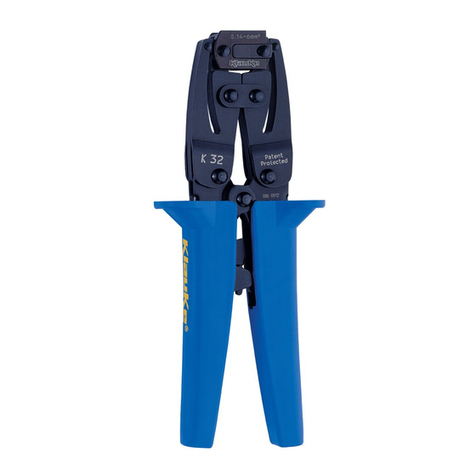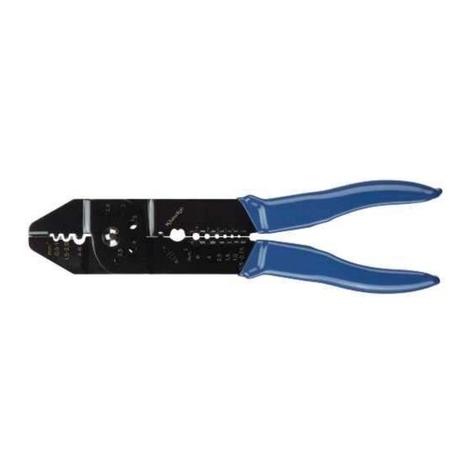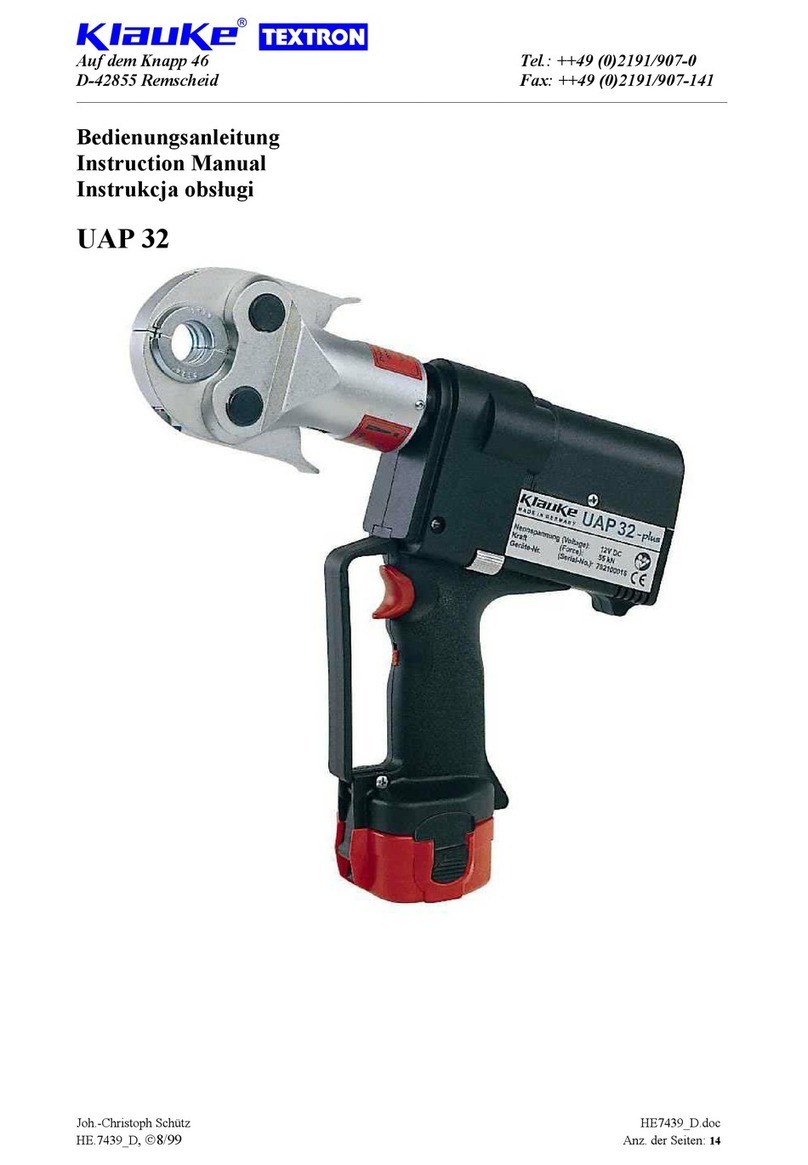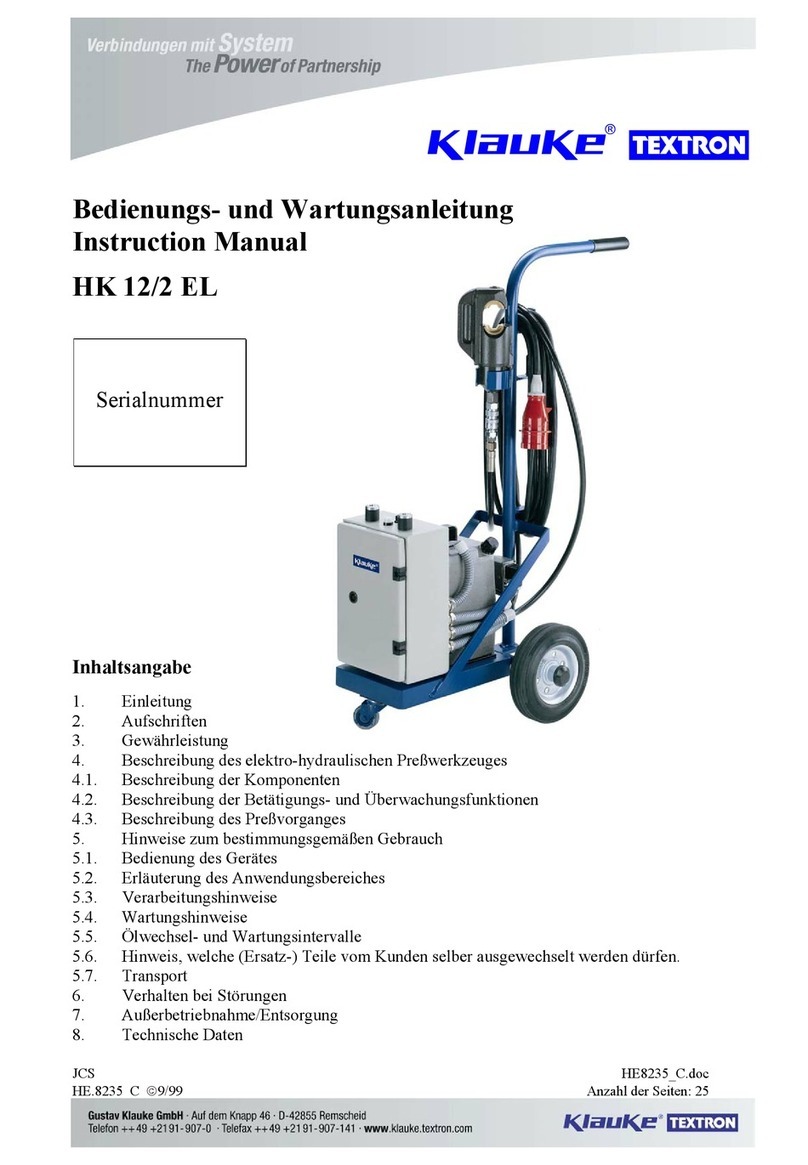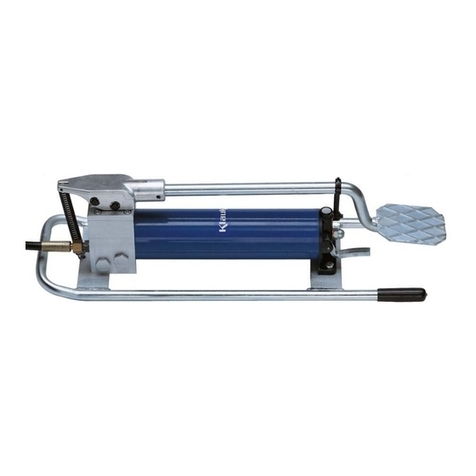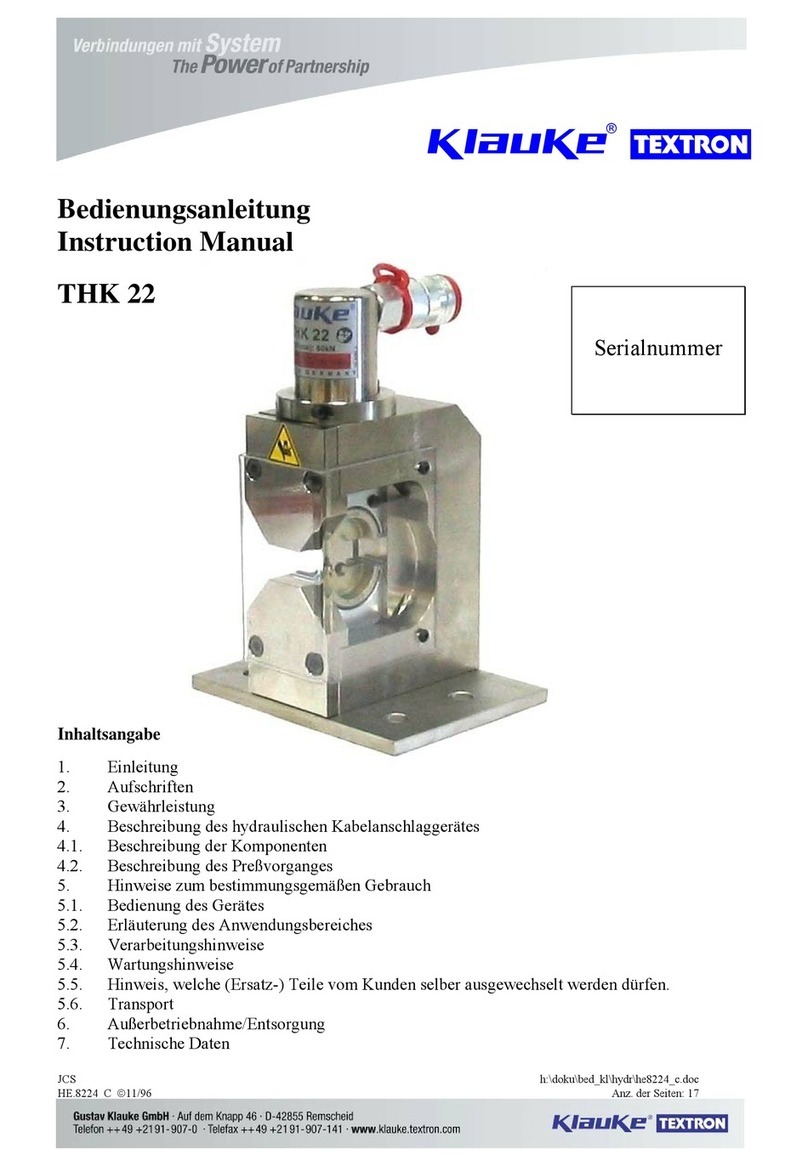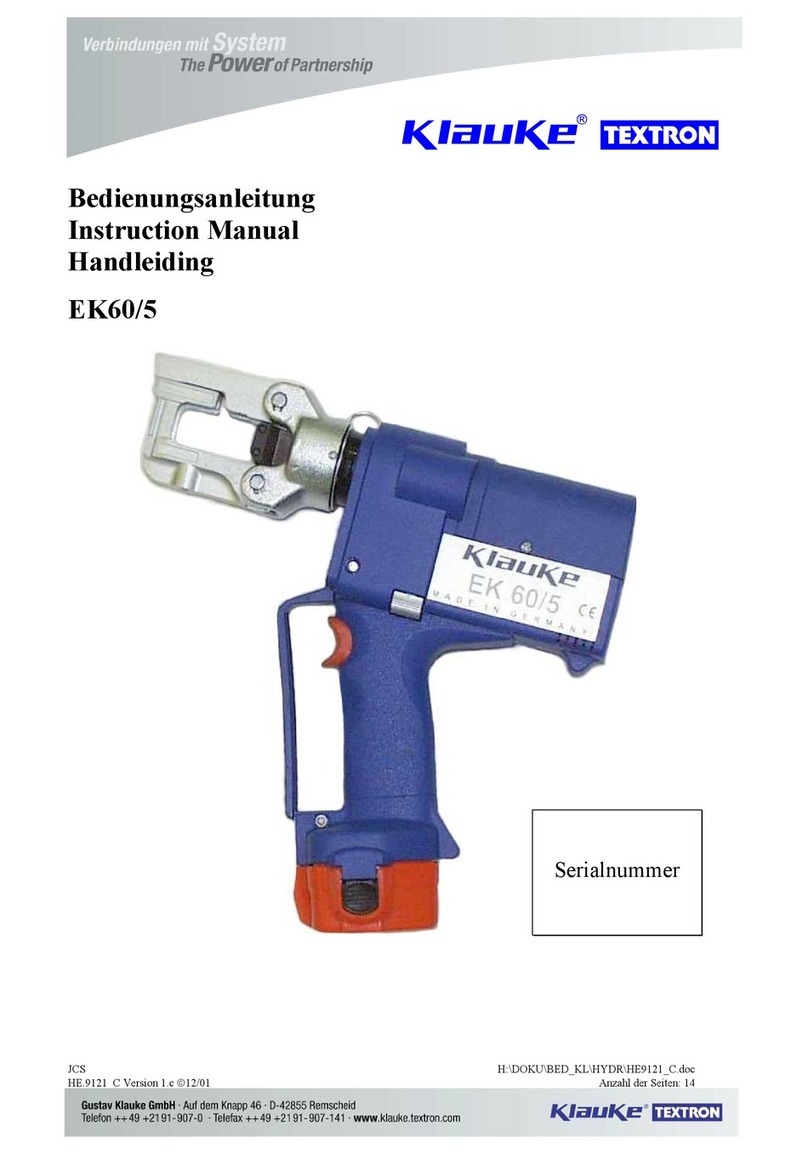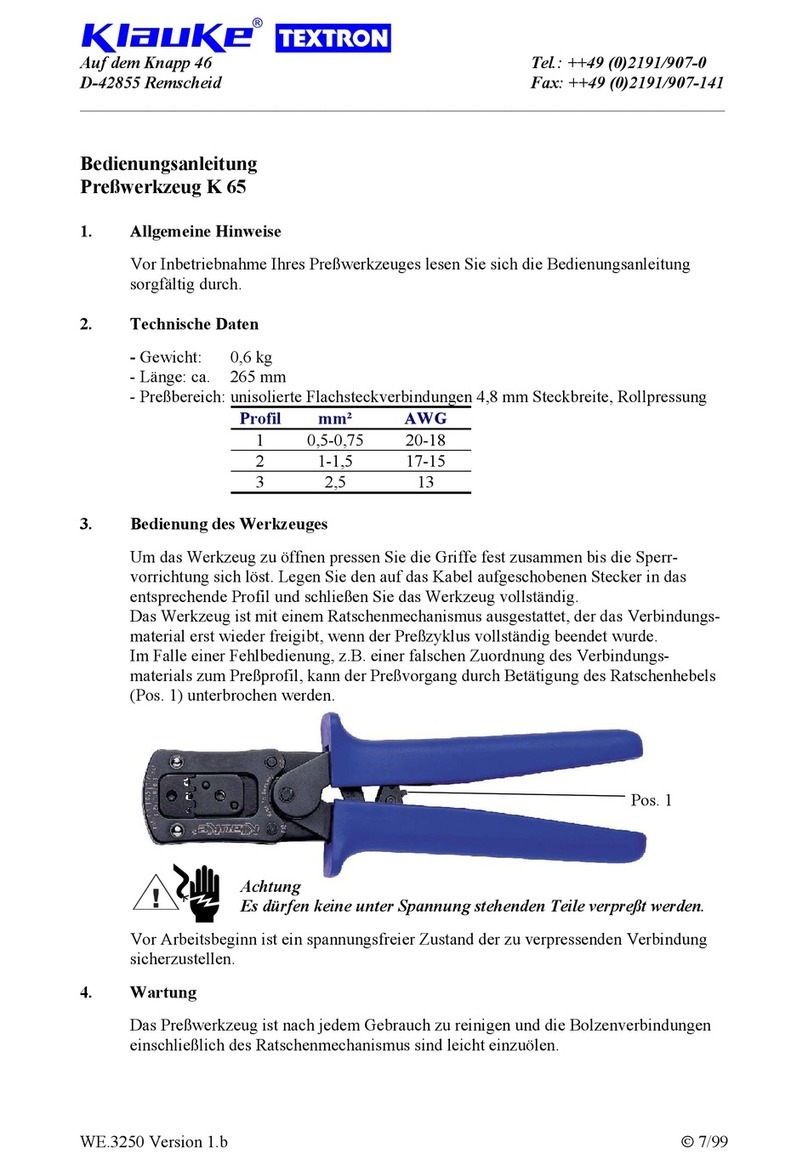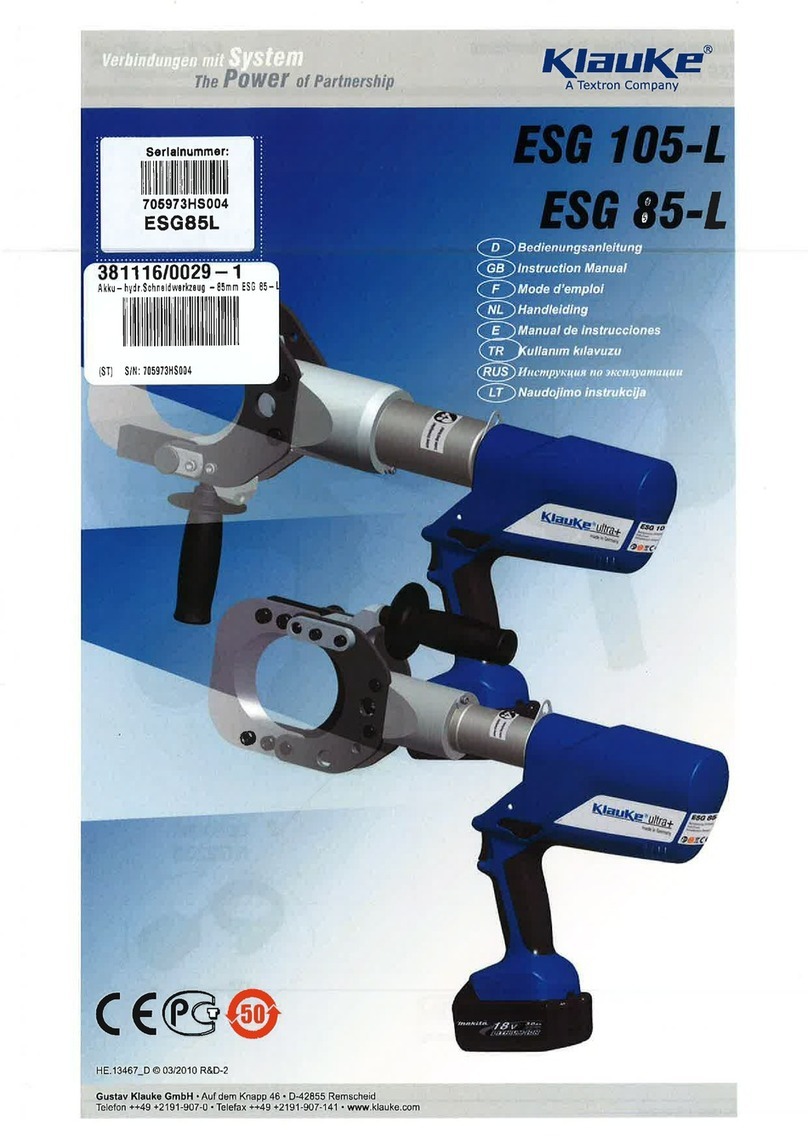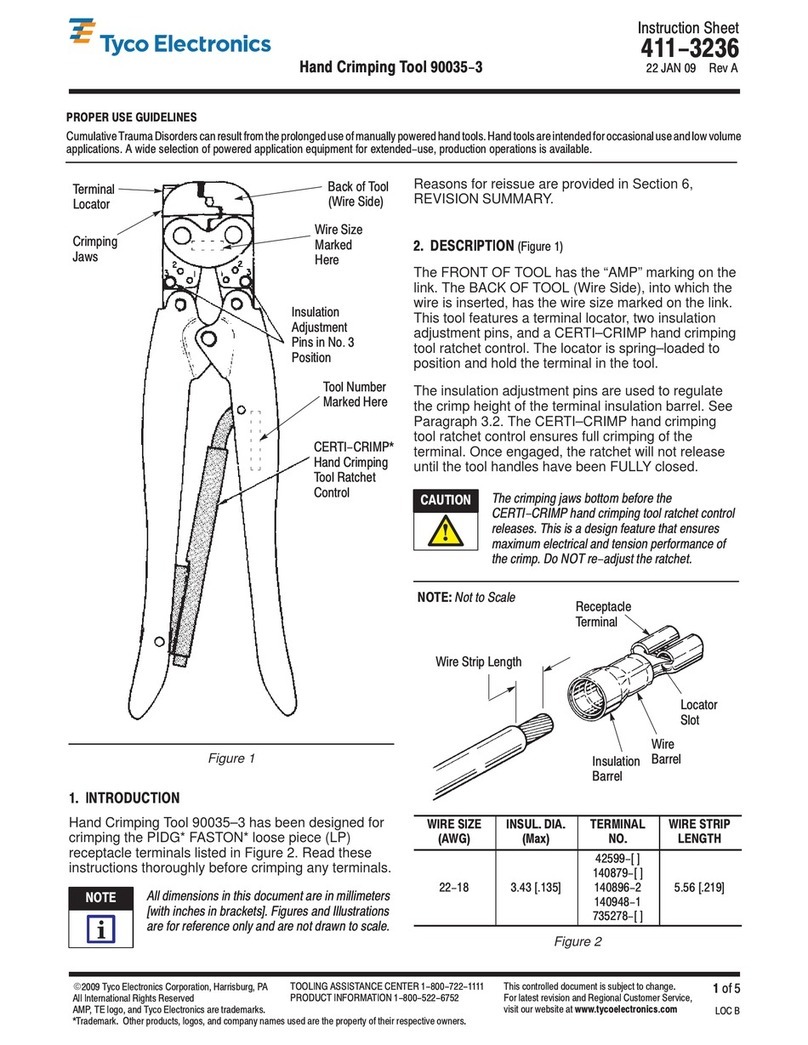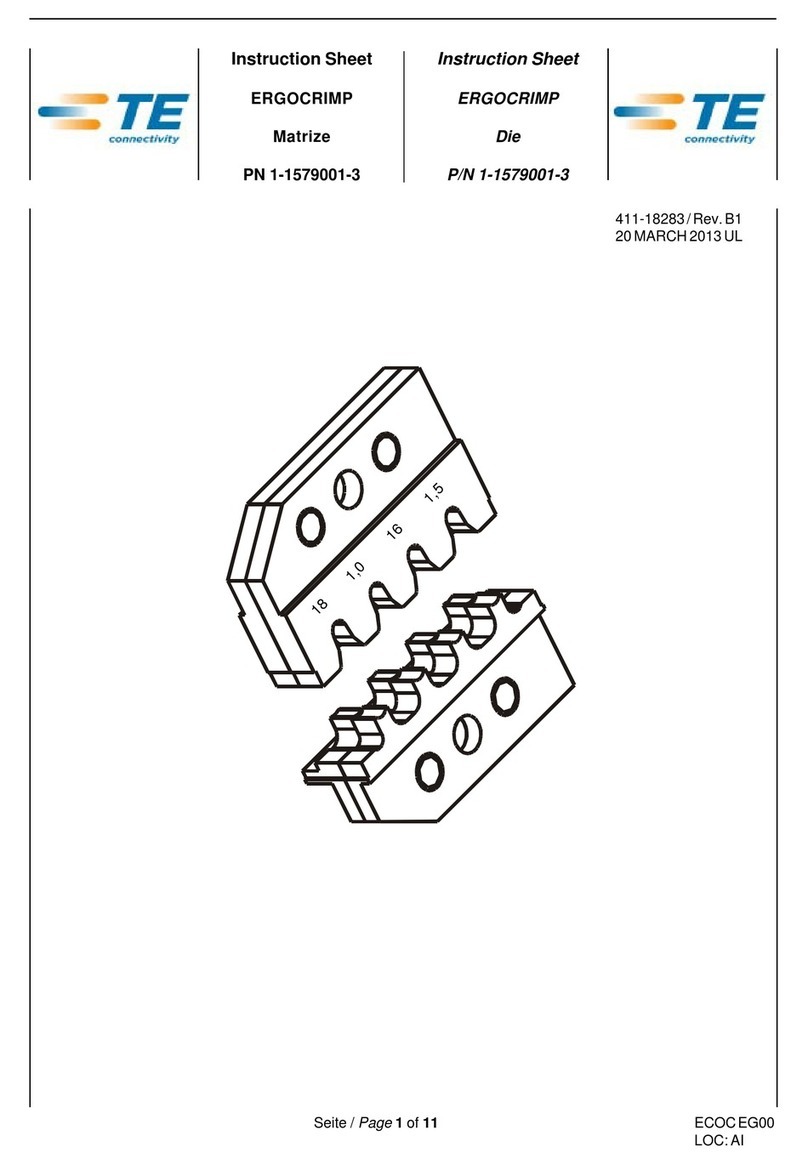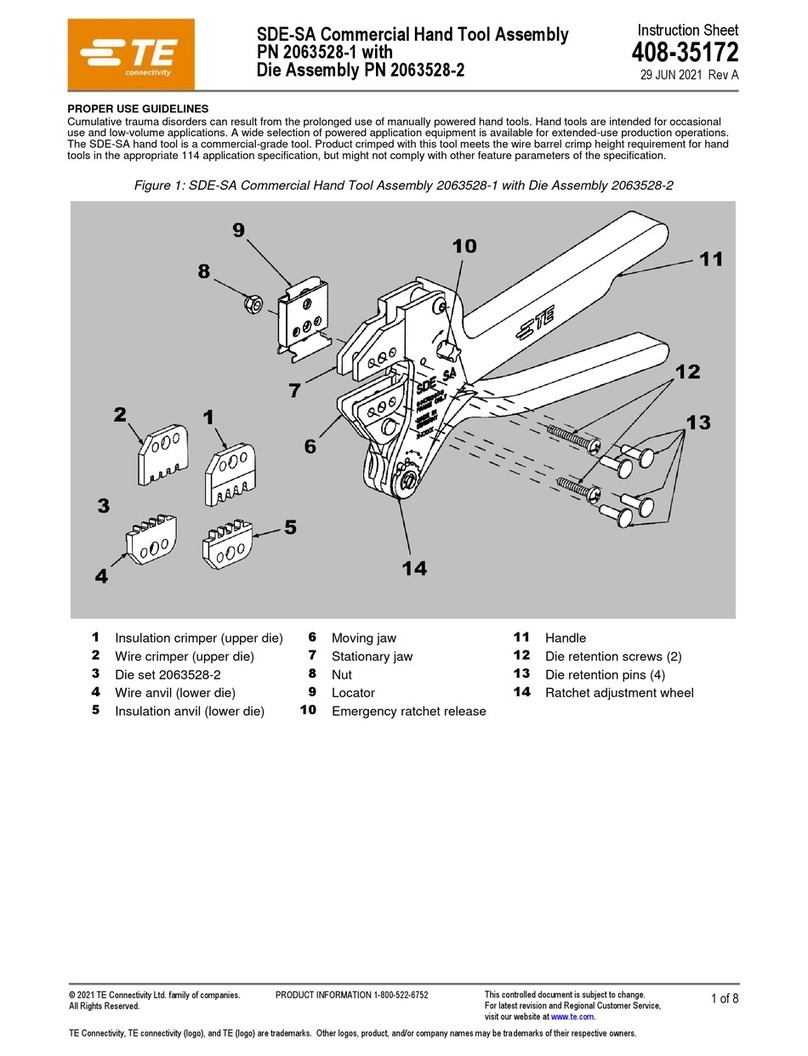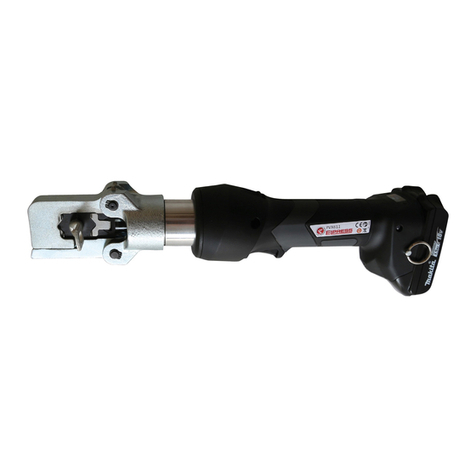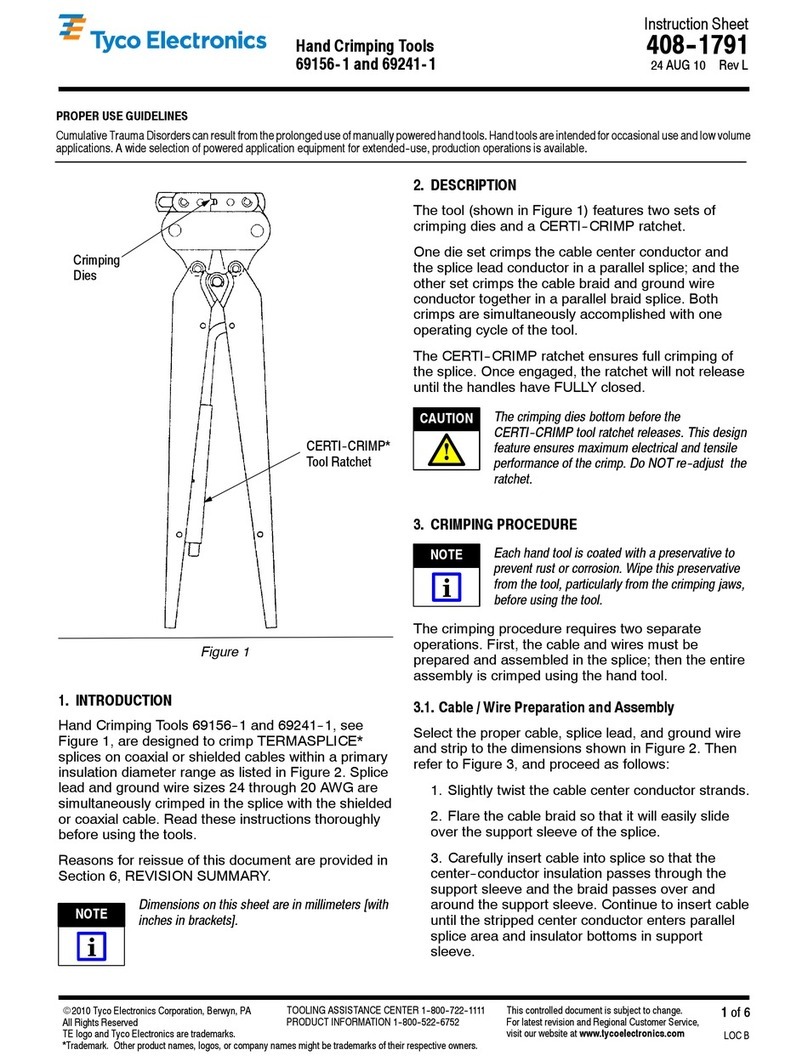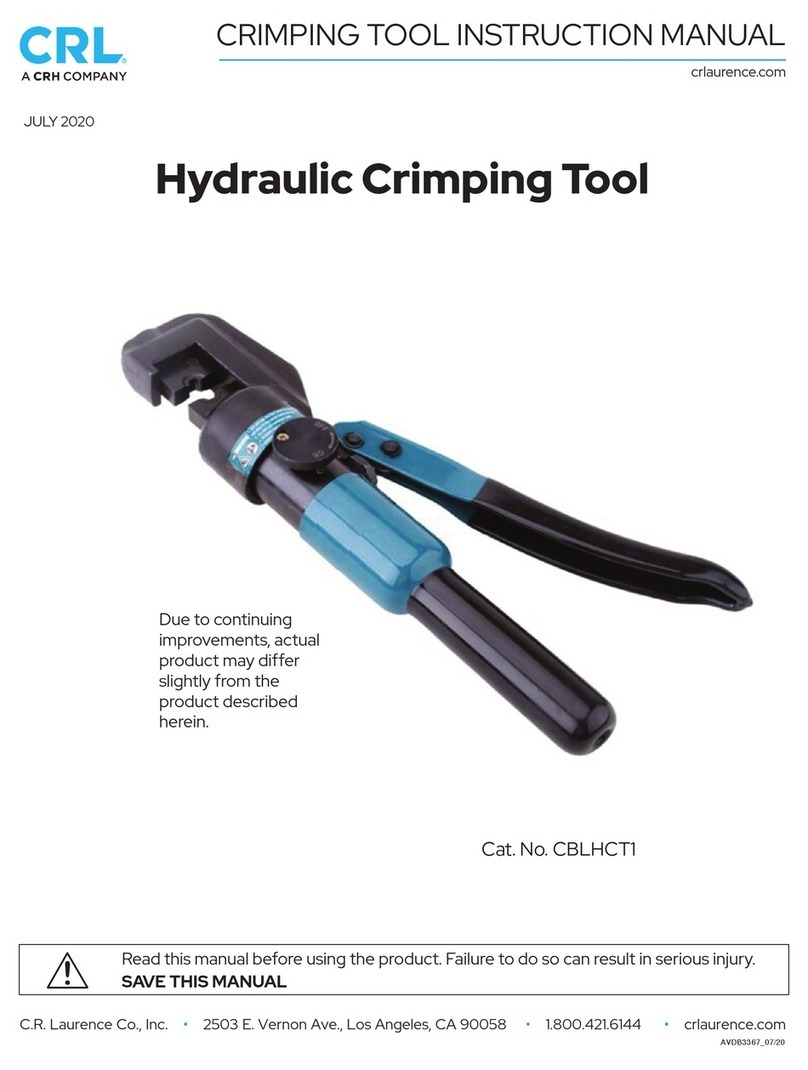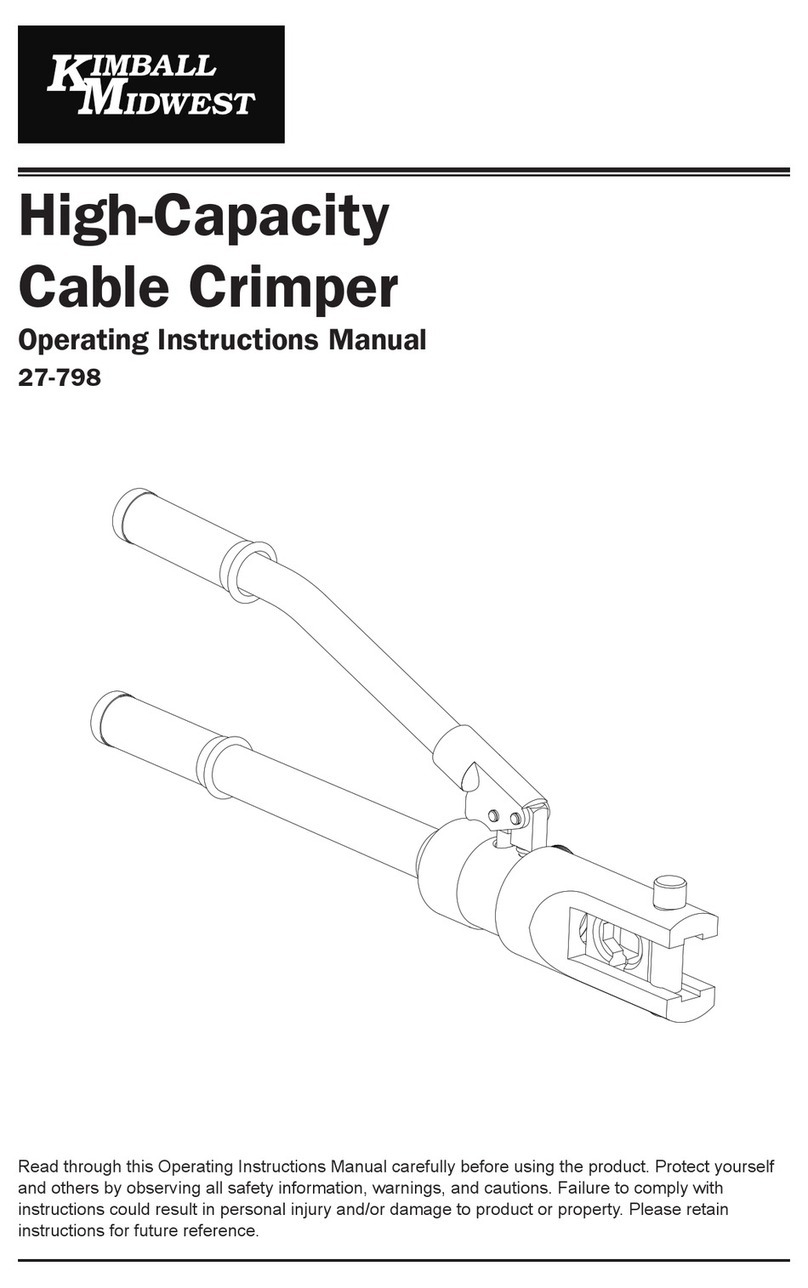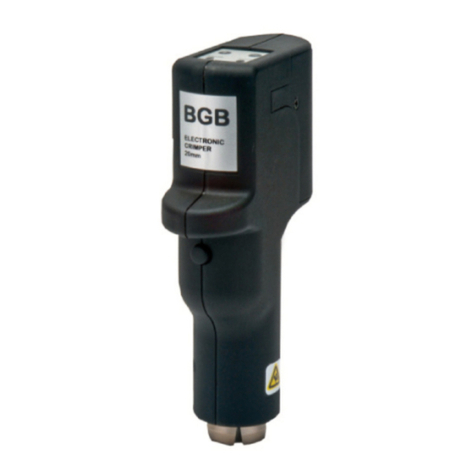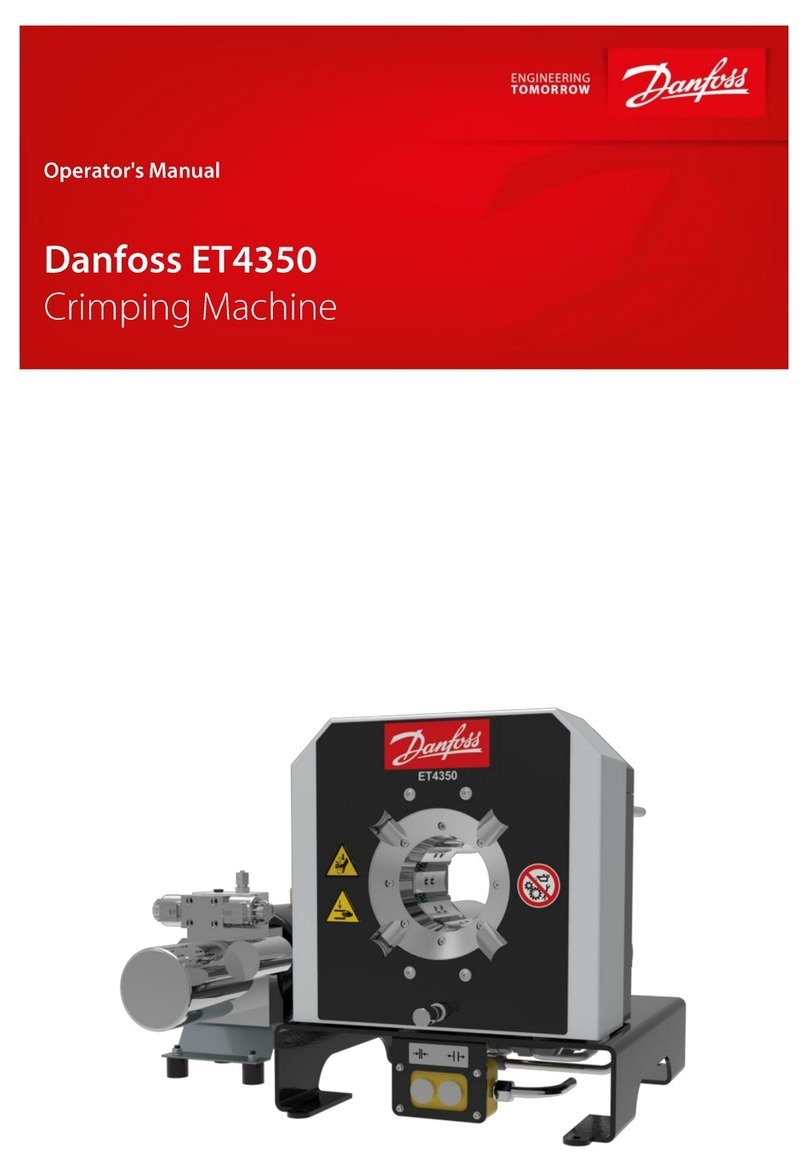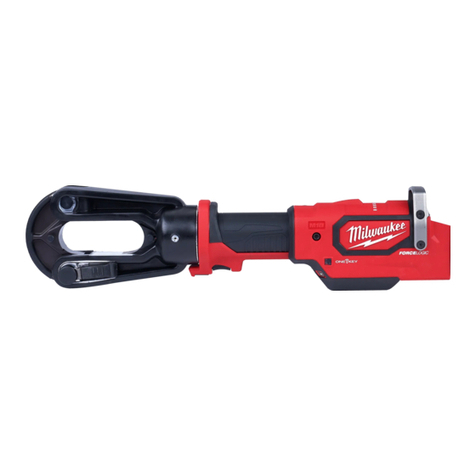
Bedienungsanleitung EK22plus Seite 6
____________________________________________________________________________________________________________________
Achtung
Beim Betrieb von Elektromotoren kann es zur
Funkenbildung kommen, durch die
feuergefährliche oder explosive Stoffe in Brand
gesetzt werden können.
Achtung
Das elektrohydraulische Preßgerät darf nicht bei
starkem Regen oder unter Wasser eingesetzt
werden.
5.3. Verarbeitungshinweise
Bitte beachten Sie unbedingt die im Katalog Kapitel 12
angeführten Montagehinweise5.
Achtung
Es dürfen auch bei gleicher Kennzahl nur die für
das Material vorgesehenen Preßeinsätze verwendet
werden.
5.4. Wartungshinweise
Das Preßgerät ist nach jedem Gebrauch zu reinigen und trocken zu
lagern. Sowohl Akku als auch Ladegerät müssen vor Feuchtigkeit
und vor Fremdkörpern geschützt werden.
Das Gerät ist wartungsfrei, lediglich die Bolzenverbindungen sind
leicht einzuölen.
Im Rahmen des bestimmungsgemäßen Gebrauchs dürfen vom
Kunden nur die Preßeinsätze (Pos.-Nr. 10) gewechselt werden.
Achtung
Geräteversiegelung nicht beschädigen!
Bei Beschädigung der Geräteversiegelung erlischt der
Garantieanspruch.
Lassen Sie Ihr Gerät nur von qualifiziertem Fachpersonal und nur
mit Originalersatzteilen reparieren. Damit wird sichergestellt, dass
die Sicherheit des Gerätes erhalten bleibt.
5.5. Hinweis zur Verwendung des Akkus und des Ladegerätes
Das Ladegerät ist für 230 V/50-60 Hz ausgelegt. Neue Akkus
müssen vor dem erstmaligen Gebrauch geladen werden. Zur
Aufladung des Akkus wird der Stecker des Ladegerätes in die
Steckdose und der Akku in das Ladegerät eingesteckt (Bild 5). Die
Ladezeit beträgt ca. eine Stunde (Bild 6). Der Ladezustand des
Akkus6wird an der Leuchtdiode am Ladegerät abgelesen.
grün: Akku ist aufgeladen
rot: Akku wird gerade geladen.
blinken: Akku nicht vollständig eingeschoben oder Akku
zu heiß, ein akustisches Signal ertönt.
Ist der Ladevorgang abgeschlossen wechselt das Ladelicht wieder
auf grün, wobei gleichzeitig ein akustisches Signal 5 Sekunden
lang ertönt.
Es dürfen keine artfremden Akkus weder in der Presse noch im
Ladegerät verwendet werden.
Laden Sie Ihren Akku auf, sobald die Geschwindigkeit Ihrer
Maschine merklich nachläßt, bzw. die Anzeige am Gerät (siehe
Kap. 4.3) auf einen leeren Akku hinweist. Laden Sie nicht
vorsichtshalber einen teilentladenen Akku nach. (Bild 11)
Wenn Sie einen Akku aus einem kürzlich betriebenen Gerät oder
einen, der längere Zeit in der Sonne lag, laden, kann das
Aufladelicht rot blinken. Warten Sie in diesem Fall eine Weile.
Das Aufladen beginnt nach Abkühlung des Akku.
Wollen Sie zwei Akkus nacheinander aufladen, warten Sie 15 min
bevor Sie den zweiten Akku laden.
5Siehe auch Bild 4 auf Seite 2 dieser Bedienunganleitung
6Der Ladezustand des Akkus kann auch an der LED des Gerätes durch
Leuchten am Ende einer Pressung erkannt werden. Siehe Kap. 4.3.
Blinkt das Aufladelicht abwechselnd rot und grün und wird ein
Warnsignal 20 sec. lang abgegeben, ist das Aufladen nicht möglich. Die
Pole des Ladegerätes oder die des Akkus sind durch Staub verschmutzt
oder der Akku ist verbraucht oder beschädigt.
Laden Sie den Akku bei einer Raumtemperatur von 0°C bis 40°C (Bild
8). Lassen Sie das Ladegerät nie im Regen oder Schnee liegen (Bild 10).
Laden Sie den Akku nicht in Anwesenheit leicht entzündbarer Stoffe
oder Gase (Bild 9).
Tragen Sie das Ladegerät nie am Netzkabel und ziehen Sie es nicht
gewaltsam aus der Steckdose heraus. Stecken Sie keine fremden
Gegenstände in die Lüftungsgitter des Ladegerätes (Bild 13).
Das Laden der Akkus darf nur in den vom Hersteller vorgeschriebenen
Ladegeräten vorgenommen werden.
Achtung
Stecken Sie den Akku nicht in Ihre Hosentasche oder in
Ihre Werkzeugkiste, wenn sich in ihnen leitfähige Teile
befinden, wie z.B. Münzen, Schlüssel, Werkzeuge oder
andere metallische Teile.
Ziehen Sie den Stecker des Ladegerätes nach dem Laden aus der
Steckdose heraus (Bild 7). Nehmen Sie das Ladegerät nicht auseinander.
Um die Sicherheit und Zuverlässigkeit des Ladegerätes zu gewähr-
leisten sollten Reparatur, Wartung oder Einstellung durch unser Service-
Center durchgeführt werden.
5.6. Aufbewahrung und Transport des Preßgerätes
Um das Preßgerät vor Beschädigungen zu schützen, muß es nach
Gebrauch und nachdem es gesäubert worden ist, in den Transportkoffer
Art.-Nr. MKE 22 gelegt werden, der dann anschließend sicher zu
verschließen ist.
6. Verhalten bei Störungen am Preßgerät
a.) Regelmäßiges Blinken der Leuchtdiodenanzeige (Pos.-Nr. 6)
=> Akku (Pos.-Nr. 7) austauschen. Leuchtet die Anzeige weiter, muß
das Gerät eingeschickt werden. (siehe auch Kap. 4.3)
b.) Das Preßwerkzeug verliert Öl.
=> Das Gerät einschicken. Das Gerät nicht öffnen und die Geräte-
versiegelung nicht entfernen.
c.) Preßwerkzeug erreicht den Enddruck nicht.
=> Preßvorgang unterbrechen. Rückstelltaste (Pos.-Nr. 2) gedrückt
halten und gleichzeitig Bedienungsschalter ca. 10 sec. Dauer-
betätigen. Wird der Fehler dadurch nicht behoben, muß das Gerät ins
Werk eingeschickt werden.
7. Außerbetriebnahme/Entsorgung
Dieses Gerät fällt in den Geltungsbereich der Europäischen WEEE
(2002/96/EG) und RoHS Richtlinien (2002/95/EG), die in Deutschland
durch das Elektro- und Elektronikgerätegesetz (ElektroG) umgesetzt
wurden.
Die WEEE-Richtlinie schreibt die Sammlung und umweltgerechte
Verwertung der Elektro- und Elektronik-Altgeräte vor. Informationen
dazu finden Sie auf unserer Homepage www.klauke.com unter WEEE &
RoHS.
Die RoHS Richtlinie untersagt nach dem 01/07/2006 neue Elektro- und
Elektronikgeräte in Verkehr zu bringen, die mehr als 0,1 Gewichts-
prozent Blei, Quecksilber, sechswertiges Chrom, polybromiertes
Biphenyl (PBB) oder polybromierten Diphenylether (PBDE) oder mehr
als 0,01 Gewichtsprozent Cadmium je homogenem Werkstoff enthalten.
Akku’s (Pos.-Nr. 5) müssen unter Berücksichtigung der Batteriever-
ordung speziell (getrennt) entsorgt werden.
Achtung
Das Gerät darf nicht im Restmüll entsorgt werden. Die
Entsorgung muß durch den Entsorgungspartner der Fa.
Klauke vornehmen werden.
Kontaktadresse: WEEE-Abholung@Klauke.Textron.com
